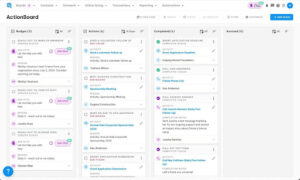How to Turn Donor Data Into Clear Next Steps (Not Another Dashboard)
min to read ✭
If you’ve ever opened a CRM or spreadsheet and been met with a wall of charts, graphs, and stats, only to walk away still wondering what exactly you should do today, you’re not alone.
Your nonprofit doesn’t need another dashboard. You need clarity. You need direction. And, most of all, you need time back.
In this blog, we’ll break down:
- The difference between reporting and actionable insight
- How to make donor data more usable (without needing a data analyst)
- And how the right tools can guide you to real action
Data vs. Action: What’s the real difference?
Reporting tells you what happened. Insight tells you what to do next.
Most donor management systems are great at reporting. They show you:
- How many new donors gave last quarter
- Who opened your last email
- Your year-to-date retention rate
But too often, it stops there. Reporting is descriptive, but what nonprofits really need is prescriptive insight.
Good data tells a story. Great insight tells you the next sentence you need to write.
You don’t raise more funds just by looking at a dashboard. You raise more funds when you know when to:
- Follow up with a lapsed donor
- Thank someone who just gave for the first time
- Reconnect with a recurring donor who missed a gift
The challenge? Many small and mid-sized nonprofits don’t have the staff or time to translate data into a game plan. That’s where the shift needs to happen.
How to make donor data more actionable (in 3 steps)
1. Identify what matters most
Start by deciding which donor behaviors are most important for your organization to act on.
If you’re wondering where to start? Consider looking into these 6 crucial donor journeys to get ideas.
Some common examples:
- First-time donors who haven’t been thanked
- Recurring donors who stopped giving
- Major donors who haven’t been contacted in 6 months
- Event attendees who didn’t convert to donors
Keep the list short. You don’t need 100 metrics, just the 5–10 that truly drive relationships and retention for your organization
2. Translate behaviors into prompts
Once you’ve chosen key behaviors, think about what action those behaviors should trigger. For example:
- If a donor gave for the first time → send a personalized thank-you
- If a donor hasn’t given in 12 months → schedule a call to re-engage
- If a donor’s birthday is next week → mail a handwritten card
This step turns vague data into real steps any staff or volunteer can take.
3. Use a tool that surfaces prompts automatically
This is where DonorDock comes in. It’s one of the few tools designed to show you exactly what you need to do, no digging required. With DonorDock’s ActionBoard and the new personal-to-you assistant, Otto, instead of opening a dashboard and guessing, you get a screen like this:

Each item on the list is generated based on donor behavior, not guesswork. Think of it as your donor stewardship to-do list, “Otto”-generated for you.
Why this matters (especially for small teams)
Small nonprofits often don’t have the luxury of a dedicated fundraiser, let alone a data analyst. You’re wearing multiple hats, juggling admin, programming, fundraising, and comms all at once.
That’s why having a system that turns data into clear, human, actionable tasks is a game-changer.
Here’s what it looks like when it works:
- You log in and see you need to thank Sarah for her recent gift → You do it.
- You’re reminded that Alex hasn’t given this year → You send a “we miss you” message.
- You see a recurring donor’s payment failed → You follow up before it becomes a long-term lapse.
Each of these small actions builds better donor relationships. That’s what leads to more retained donors, more giving, and less burnout for your team.
Reporting isn’t the goal → relationships are
At the end of the day, your mission isn’t to generate reports. It’s to grow relationships, inspire generosity, and make a difference in your community.
Data should support that, not stall it.
So here’s the mindset shift:
Stop asking:
“What’s the data telling me?”
Start asking:
“What’s my next step?”
When your tools answer that question for you clearly, simply, and consistently, fundraising becomes less of a guessing game and more of a rhythm.
Final thoughts: Less dashboard, more direction
If you’re tired of drowning in data but starving for clarity, you’re not alone.
DonorDock’s ActionBoard and Otto is one example of how tools are evolving to serve real nonprofit needs, not just big orgs with big budgets.
Whether you use DonorDock or another platform, the key is the same: Don’t just track your donors. Take action on what they’re telling you.
Let your data work for you and get back to the meaningful work of building relationships that fuel your mission.
Want to see how DonorDock can take the guesswork out of your fundraising? Request a demo today!




